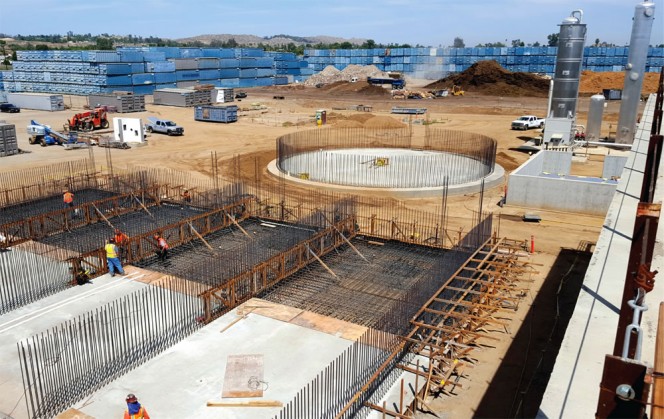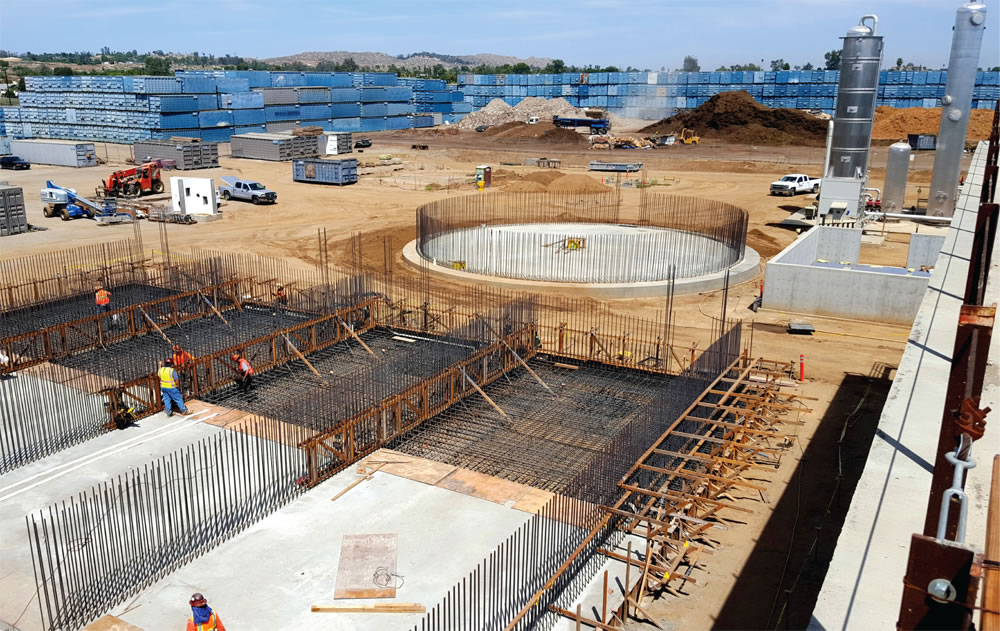Phase I of CR&R’s yard trimmings and food waste digester gets ready to move into start-up mode.
Nora Goldstein
BioCycle October 2015

Phase 1 of CR&R’s new AD system has capacity to process 83,600 tons/year of yard trimmings and food waste. Four Eisenmann digesters are housed in the rectangular building; the fueling station is in the foreground.
Photo courtesy of CR&R, Inc.
Construction is nearing completion, and all the equipment is installed at CR&R Inc.’s high solids anaerobic digester (AD) facility in Perris, California. “We are approaching a dry run with the digester to test out the various system components, and then will fine-tune the process controls,” notes Paul Relis, CR&R Senior Vice-President. “We will likely start processing feedstocks in the digesters in the first quarter of 2016.”
CR&R is building the digester in four phases; each phase is designed to process 83,600 tons/year. Once completed, the $100 million facility will have the capacity to process 335,000 tons/year of grass clippings, landscape waste and pre and postconsumer food scraps, as well as liquids such as off-spec beverages, fats, oils and grease, and other high strength liquids. CR&R is a regional solid waste management company, servicing the residential, commercial and industrial sectors. The anaerobic digester is installed at CR&R 52-acre solid waste transfer station and materials recovery facility in Perris (Riverside County) that is permitted for 3,000 tons/day of incoming material. CR&R services multiple cities under contract for waste services from this location.
“We have signed contracts with eight municipalities to provide three container service — organics, recycling and trash — to their households,” explains Relis. “These contracts fill up our capacity for Phase 1, and we are well on our way towards reaching our Phase 2 capacity. Households can put food scraps and incidental paper in their organics bins. The contract fees for organics collection and digestion come out to about $2 to $2.50/household/month.” Overall, CR&R’s contracts include commercial and residential service; commercial organics service will be phased in as California’s AB 1826 law goes into effect in 2016, starting with the largest generators of food waste.

During construction, the foundation was also poured for the Phase 2 build out, which will include another four digesters (Phase 1 digesters during construction in foreground above).
Photo courtesy of CR&R, Inc.
He adds that securing these municipal contracts was the cornerstone of making the AD project a reality. “We wouldn’t have built this facility if we didn’t have municipal contracts to secure our feedstocks and our financing,” notes Relis. “With our growing contract base secure we can focus on making sure our plant performs within the measures we’ve established. We will soon start processing predominantly green waste, with incidental food scraps in the green bin, and then incrementally build our reach into the food waste business.”
During construction, the foundation was also poured for the Phase 2 build out. And the installed biogas conditioning and compression equipment is sized to service Phases 1 and 2. “The key point is we have gone a good way towards Phase 2 with our Phase I investment,” says Relis. “This also helps us manage the overall capital costs of the facility.” CR&R has received grant funding from the California Energy Commission, CalRecycle and the South Coast Air Quality Management District for the project.
System Design
The facility is using the Eisenmann high solids anaerobic digestion technology. The receiving building, which was sized to accommodate all four phases of the facility, houses conveyors, overhead magnets and eddy current separators to remove contaminants; feedstocks will then be sized to 1.5 inches. “The AD plant is a hybrid system that can take liquids and solids simultaneously,” explains Michael Silva, the AD project manager. “The average solids content going into the digesters is 40 to 50 percent. There is a receiving tank for liquids, and that will be used to increase moisture content as needed.”
There are four digesters, each with a center mixer. “The Eisenmann system is both plug flow and mixed, with a retention time of 21 days,” adds Silva. “It operates continuously, and we have the option of running at either mesophilic or thermophilic temperatures, depending on the feedstock mix. After digestion, material goes through a screw press to separate out the solids, which will either go to a wholesaler, composting facility or the best option, directly to farm fields. The liquids are taken off site as fertilizer. Neither the solids nor the liquids are stored on site, and nothing gets recirculated to the front of the digester or discharged to a sewer. Basically, none of the outputs ever touches the ground.”
CR&R intends to start by targeting agricultural markets for the digestate, along with nurseries and bagged product lines. “Basically, we are exploring all kinds of markets,” notes Relis, “and we can’t say with certainty which one, or in what combinations, will be optimal.”
Once the digester system is running, it will primarily be operated by computer-managed process control technology. “CR&R is designing the entire software program and we are integrating the entire system — preprocessing, anaerobic digestion, digestate management and biogas utilization,” explains Silva.
Biogas Markets
All biogas generated will be conditioned and compressed using Greenlane Biogas technology for vehicle fuel and pipeline injection. Phase 1 is expected to produce 1,000,000 diesel gallon equivalents (DGE) of vehicle fuel. CR&R operates about 900 trucks; about one-third of the fleet operates on compressed natural gas (CNG). The Perris site has a CNG fueling station. “One million DGE is equal to fueling about 80 trucks with compressed renewable natural gas (RNG),” says Relis. “We also are working towards injecting RNG into the pipeline and wheeling it to other CR&R yards with CNG stations. And there may be cities participating in our program that would like to buy renewable CNG back from us.” Ultimately,
4 million DGE will be produced when the facility is fully built out.
CR&R was selected as part of a test fleet for an 8.9-liter ISL G engine from Cummins Westport, which was certified in California recently at “0.02 grams per brake horsepower of NOx,” according to Fleet & Fuel, which is equivalent to near zero emissions. The heavy-duty engine runs on RNG.
No CHP engines are being installed at the CR&R AD plant. To keep the digesters at optimum temperature, heat will be recovered from the biogas upgrading system, and CR&R is installing an on-site boiler to provide supplemental heat as needed. The digesters are also fully insulated, and notes Relis, “we expect that microbes will generate a lot of heat themselves.”












